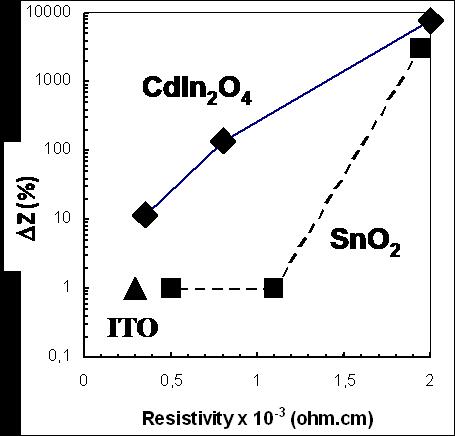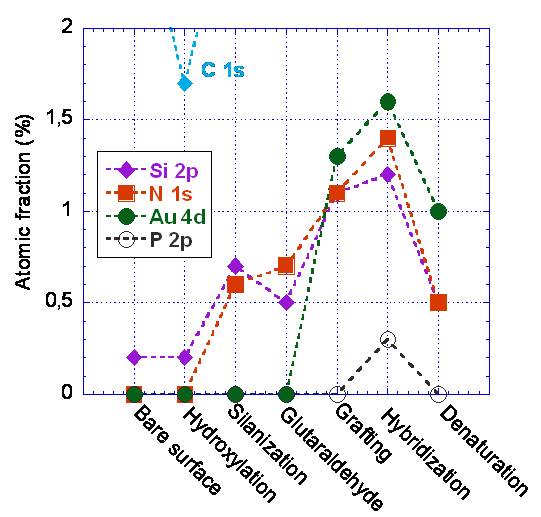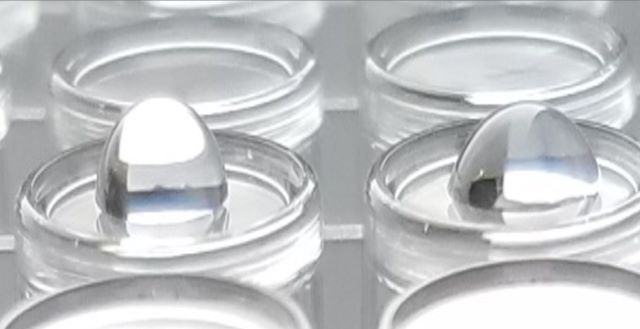Label-free biosensing allows direct and simple detection of biological species on solid surfaces.
It does not require the use of radioactive / fluorescent labels that introduce complexity and potential contamination to biological material in vitro. As a counterpart, label-free biosensing relies on some changes of physical characteristics of the sensitive material upon the biological event. That is why the chemical nature, the physical characteristics (microstructure, porosity, electrical and optical properties, surface morphology...) of the transducer as well as its functionnalisation process are of major importance.
These parameters must be perfectly controlled and optimized to improve the quality of the measured signal (sensitivity).
Our research mainly focuses on the electrochemical label-free biosensing of some biological species on semiconductive oxide films. Films are prepared under different elaboration conditions to vary their physical properties and to know their influence on the detected signal [1-5]. Besides, we perform label-free optical transduction using SPR [6] and SERS techniques [7].
Semiconductive oxides for Electrochemical Detection of DNA
Crystalline and dense semiconductive oxides thin films such as SnO2, CdIn2O4, ITO are grown by MOCVD. Their surface is functionnalized and DNA modified. Combining techniques such as XPS (Fig. 1), AFM or ToFSIMS, the efficiency of DNA surface immobilisation on the semiconductive oxide film surface is assessed using specific Au NP monolabelled DNA strands [2]. DNA surface density can be estimated to be 2-4 x 1011 mol/cm2.

Figure 1. evolution of atomic fractions (%) of Si, N, P and Au elements as a function of the functionnalisation step in case of ITO films. Si and N are characteristic of the aminosilane (APTES), whereas N, P and Au correspond to DNA. The DNA strands are monolabelled by a gold nanoparticle.
Non-labelled DNA detection is assessed by electrochemical impedance spectroscopy (EIS) as well as by electrical I(V) measurement on the different semiconductive oxides : SnO2, CdIn2O4 and ITO. In both detection methods, results are similar. They emphasize a strong influence of both the oxide chemical nature and the resistivity on the detected signal. Accordingly, resistive CdIn2O4 or SnO2 films provide high impedance variation upon DNA detection whereas conductive ITO films provide poor variation (Fig. 2). In the case of slightly doped and resistive films, the field effect phenomenon (FET) due to the presence of negatively charged DNA molecules on the oxide surface is maximum [4, 5]. This result provides the guidelines for further uses of semiconductive oxide films in view of biomolecular sensing.
An increase of the oxide film sensitivity can be expected by turning the film morphology from a dense structure into a porous nanostructures with a high shape ratio : nanowires. To this end, we presently develop the electrodeposition technique and study the best condition parameters to obtain SnO2 nanowires.

Figure 2. variation of impedance (%) obtained from spectroscopic impedance measurement upon DNA detection as a function of film resistivity for different metal oxide films : CdIn2O4, ITO and SnO2.
Collaborations : JP Diard (LEPMI-Grenoble), P. Pigram (University La Trobe, Australia), A. Laurent (BioMérieux, Grenoble), R. Sanjines (EPFL, Suisse).
Project : Network of Excellence Nanofunction
References :
[1] V. Stambouli et al, 2006, Electrochem. Acta 51 : 5206-5214
[2] V. Lavalley et al. , 2007, Surf. Sci. 601 : 5424-5432
[3] M. Manesse et al., 2008, Electrochemistry Comm. 10 :1041-1043
[4] A. Zebda et al., 2010, Sensors and actuators B 144, 176-182
[5] V. Stambouli et al.,2012, Thin Solid Films 520, 3878
[6] M. Manesse et al., 2009, Langmuir, 25 : 8036
[7] M. Langlet et al., 2011, Surf. Sci. 605 : 2067
Bacteria detection
Some bacteria are henceforth known to use oxides instead of oxygen as electron acceptors for their respiratory mechanism. This observation was recently extended to other types of bacteria in microbial fuel cell. In this case they use an electrode for ending their respiratory electron transfer chain. We are presently working at using this interesting bacterial behavior to early detect them in a specific environment.



